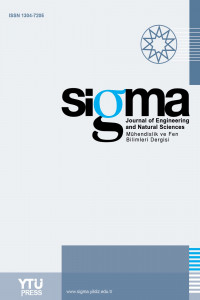IMPROVEMENT OF WATER-BASED INTERIOR DYES PREPARED BY USING NATURAL MINERAL AND FIBER INDUSTRIAL PLANT
Abstract
In this study, natural minerals and industrial fibrous plant waste were supplied from various regions of Turkey unlike from the literature. Dye application was carried out with 200 µm applicator on standard sizes (10 cm x 10 cm) of metal surfaces. The dyed this original mixture was applied on the block and panel building materials. Dyes were examined according to the features of unaffected by water, not changed the nature and physical strength, high concealer effect in detail. As a result, the optimum process parameters (for two different natural minerals and the amount of industrial fibrous plant waste) were determined. The statistical method was used and the results obtained were analyzed comparatively in terms of improving both cost and quality for determination of optimum process parameters. In conclusion, the test results (concealer property, hydrophobicity, impact and adhesion tests) and results showed that the usage of natural minerals and industrial fibrous plant waste effected the production of insulated interior dye, positively.
Keywords
References
- [1] Binici H., Eken M., Dolaz M., et.al., “An Environmentally Friendly Thermal Insulation Material from Sunflower Stalk, Textile Waste and Stubble Fibres”, Constr. Build. Mater., 51, 24, 2014.
- [2] Pinto J., Varum A.P.H., Costa A., et.al., “Corn's Cob as a Potential Ecological Thermal Insulation Material”, Energy Build., 43(8), 1985, 2011.
- [3] Briga-Sá A., Nascimento D., Teixeira N., et.al., “Textile Waste as an Alternative Thermal Insulation Building Material Solution”, Constr. Build. Mater., 38, 155, 2013.
- [4] Papadopoulos A.M., “State of The Art in Thermal Insulation Materials and Aims for Future Developments”, Energy Build., 37(1), 77, 2005.
- [5] Papadopoulos A.M., Giama E., “Environmental Performance Evaluation of Thermal Insulation Materials and Its Impact on the Building”, Build. Environ., 42(5), 2178, 2007.
- [6] Mahlia T.M.I., Taufiq B.N., Masjuki H.H., “Correlation Between Thermal Conductivity and the Thickness of Selected Insulation Materials for Building Wall”, Energy Build., 39(2), 182, 2007.
- [7] Sjöberg A.M., Kymäläinen H.R., “Flax and Hemp Fibres as Raw Materials for Thermal Insulations”, Build. Environ., 43(7), 1261, 2008.
- [8] Benk A., Çoban A., “Possibility of Producing Light Weight, Heat Insulating Bricks from Pumice and H3PO4- or NH4NO3- Hardened Molasses Binder”, Ceram. Int., 38, 2283, 2008.
- [9] Sanchez-Cruz P., Dejesus-Andino F., Alegria A.E., “Roles of Hydrophilicities and Hydrophobicities of Dye and Sacrificial Electron Donor on the Photochemical Pathway”, J. Photoch. Photobio. C., 236, 54, 2012.
- [10] Xiao Y., Wiesner M.R., “Characterization of Surface Hydrophobicity of Engineered Nanoparticles”, J. Hazard. Mater., 215, 146, 2012.
- [11] Tsui K.L., “An Overview of Taguchi Method and Newly Developed Statistical Methods for Robust Design”, IIE Transactions, 24(5), 44, 1992.
- [12] Vankantia V.K., Ganta V., “Optimization of Process Parameters in Drilling of GFRP Composite Using Taguchi Method”, J. Mater. Res. Technol., 3(1), 35, 2014.
- [13] Tong L.I., Su C.T., Wang C.H., “The Optimization of Multi-response Problems in the Taguchi Method”, Int. J. Qual. Reliab. Manage., 14(4), 367, 1997.
- [14] Phadke S.M., “Quality Engineering Using Robust Design”, Prentice Hall, Englewood Cliffs, New Jersey, USA, 1989.
- [15] Kaushik G., Thakur I. S., “Isolation and Characterization of Distillery Spent Wash Color Reducing Bacteria and Process Optimization by Taguchi Approach”, Int. Biodeter. Biodegr., 63, 420, 2009.
- [16] Oz E., “Avaliability of Acidic Light Pumice as Concrete Aggregate Around Nevsehir”, Master of Thesis, Cukurova University, Adana, 2007.
- [17] Negis F., “Zeolite Based Composites in Energy Storage”, Master of Science in Materials Science and Engineering, Izmir Institute of Technology, Izmir, 1999.
- [18] Baran Acaralı N., Güreş S., Kandilci H.G., ve diğerleri, “Yalıtım Esaslı İç Cephe Boyalarının Karakterizasyonu ve Isı Yalıtımı Üzerine Etkisi”, 11.Ulusal Kimya Mühendisliği Kongresi (UKMK-11), Eskişehir, 2-5 Eylül, 2014.
- [19] Nakajima A., Hashimoto K., Watanabe T., “Recent Studies on Super-hydrophobic Films”, Monatshefte fur Chemie, 132, 31, 2001.
- [20] Güreş S., Baran Acaralı N., Kandilci H.G., et.al., “Investigation of Parameters Affecting Thermal Insulation for Decorative Insulated Interior Paint”, Paintistanbul 2014, Istanbul, Turkey, 2014.
- [21] Kendall K., “The Adhesion and Surface Energy of Elastic Solids”, J. Phys. D: Appl. Phys., 4, 1186, 1971.
Details
| Primary Language | English |
|---|---|
| Journal Section | Research Articles |
| Authors | |
| Publication Date | March 1, 2016 |
| Submission Date | June 30, 2015 |
| Published in Issue | Year 2016 Volume: 34 Issue: 1 |
IMPORTANT NOTE: JOURNAL SUBMISSION LINK https://eds.yildiz.edu.tr/sigma/


